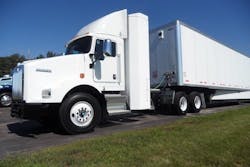Diesel dominates heavy-duty trucks, especially construction trucks, and will continue to because the engines are so efficient and the fuel is so energy rich. But cheap natural gas is gaining interest, in spite of high upfront costs for specially equipped trucks and fueling stations. Until this spring, only two gas-burning engines were available right from truck factories; one big and complex, and the other a little too small and underpowered to work in heavy, high-speed applications.
That has changed with the advent of the Cummins ISX12 G released in March. Based on a competent and popular diesel, this new gas engine has the displacement—11.9 liters or about 727 cubic inches—to make the power and torque needed for highway service. The 8.9-liter ISL G was barely adequate, and the dual-fuel 15-liter Westport HD is complex and expensive. Executives at the truck builders say the ISX12 G is what many fleet managers wanting to climb aboard the natural gas bandwagon have been waiting for.
Like the 8.9G, the 12G uses spark ignition and burns only natural gas, so its exhaust system needs only a three-way catalyst to meet emissions limits. The 15G burns both diesel and gas, so it requires a particulate filter and urea-injection equipment, along with a catalyst, to be legal. The 12G’s first version produces 350 horsepower, but in August Cummins released a stronger 400-horsepower version that should become the preferred version for highway service.
The ISX12, whether in D or G trim, is just the right size to power heavy construction trucks, and the G version could save managers a lot of money in fuel. That’s if they could find enough money in their wallets and room on the chassis to park a set of big “bottles” to hold the gas in compressed form. There’s no space to spare on a multi-axle dump truck, but when diesel fuel goes back above five bucks a gallon, as it did in some places in 2008, then climbs toward six and seven dollars, as some gurus insist it will, then more than a few guys will find the money and the frame space to install those tanks. And engines like the ISX12 G will be under the trucks’ hoods.
That’s why people from Kenworth Truck hosted a mid-summer “natural gas summit” at their plant in Chillicothe, Ohio. They gathered a half-dozen gas-powered KWs built for different applications and offered them them to a small band of press reporters for their inspection and evaluation. A few fellows with CDLs, like me, took them for drives, and one of them—again me—had a small adventure while piloting a 12G-powered T800 short-haul daycab tractor pulling a 53-foot van trailer.
See, the first thing a driver needs to know about natural gas is not how cheap it is, but where the “on” switch for the fuel system is located. I didn’t and ran out of gas a few minutes after leaving a staging area, and while sitting in a left-turn lane at a busy intersection (ha ha, look at the driver’s red face!). Because I had left my cell phone in another truck, I had to hoof it back to the staging area to get help. A couple of workers from the plant went out, turned on the switch (which activates a solenoid to open the fuel line to the engine), twisted the key, and it started right up. Yes, I felt stupid.
Let me try to explain away my ignorance. Earlier I had climbed into a 12G-powered T800 truck that wouldn’t start for me until someone showed me a rocker switch, mounted to the right of the steering column and innocuously labeled “spare,” and pushed it On. Then the engine cranked over and fired up. The T800 tractor had the same switch in the same place, but pushing it On didn’t do anything. Turns out there was a second “spare” switch to the left of the column, above the ignition, which I didn’t see. That’s the one that was wired to the tractor’s fuel system, so bingo!
The KW people said they’d have to talk to the upfitter about labeling the fuel-system switch with something specific, like, well, “fuel system.” Lacking that, someone needs to tell the driver about it. He’d also need to know where the shutoff valves are. On this tractor, they were at the lower corners of the tank cabinet, one on each side. I did check them after the engine quit and found that they were on. In reality, because natural gas is feared as being explosive, fleets adopting it for their trucks are likely to train drivers rather thoroughly on the fuel system and how to safely fill the tanks. Or they’ll mean to, but there are always some guys who just don’t get the word.
Anyway, those factory guys returned the tractor and trailer to the staging area, and I hopped in again to give it another try. This time it ran fine except for a few minor quirks:
- The engine seemed to bog a bit at clutch engagement using only the torque available at idle, so I learned to feed it a little gas and slip the clutch to get us going—not the best way to drive a big rig, but necessary in this case.
- The engine surged slightly as I accelerated in the lower gears, then smoothed out.
- Strange, sharp noises came from behind the dashboard or under the floor during gear changing, as though gas were popping out of a relief valve, even though it wasn’t (and I never got so much as one whiff of gas). Those noises, too, went away at higher road speeds.
Some spark-ignited gas engines are quieter than their diesel counterparts because the muted banging of compression ignition is absent. Although the ISX12 G was quiet in this vehicle, there was no diesel version present for comparison. There were several Paccar MX-13 diesels in a few other vehicles, and like other late-model diesels, they were so quiet and civilized that there might not be much of a difference.
Noise (or lack of it) aside, this 12G was more than powerful enough to move the truck smartly onto nearby U.S. 23, a four-laner that’s the main north-south highway in these parts, and keep it rolling on the level and up shallow hills. The rig weighed about 72,000 pounds, which wasn’t a major challenge, and the well-ratioed, easy-shifting and fun-to-drive Fuller 13-speed manual gearbox made the most of the engine’s modest output. Revs at a 65-mph cruising speed in 8th-high (13th ratio) were about 1,325, just like a modern diesel. This might be 1,500 or 1,600 in a vocational truck, and in fact that’s where the engine spun in 8th-direct (12th ratio). Either way, it remained quiet.
Unlike the ISL G that must be taken with an Allison automatic, the ISX12 G is burly enough to work with a manual transmission, which saves some serious money. Even so, a 12G with a manual is priced about $10,000 more than the 8.9G with the Allison. Hey, what’s that when you’re spending $50,000 or $60,000 more for a gas-fired truck or tractor than for a diesel? But cheap prices per diesel-equivalent gallon—$2.00 or $1.70 or even less—will pay off the purchasing premium, and even the cost of an expensive fueling station, in two or three years. That’s the attraction that’s causing the action.
About the Author

Tom Berg
Tom Berg is widely acknowleged as one of the top truck writers in the industry. He has covered construction for more than 34 years, and has test-driven well over 150 trucks for Construction Equipment.
